Leadership in Public Health: Styles, Approaches and Leader Interviews
VerifiedAdded on 2023/06/14
|12
|3070
|334
Essay
AI Summary
This essay delves into the critical role of leadership in the public health sector, contrasting leadership with management and examining different leadership styles and approaches. It highlights the importance of leadership in aligning health services and adapting to the changing needs of patients. The essay features interviews with two public health leaders, Dr. Ernest Madu and Dr. George Benjamin, comparing their leadership styles—trait-based versus situational. The analysis reveals the advantages and disadvantages of each approach, emphasizing the adaptability of situational leadership in demanding public service scenarios. A self-assessment of leadership style, using Robert Katz's three-skill approach, is also included, alongside a discussion of mentorship and leadership development in public health.
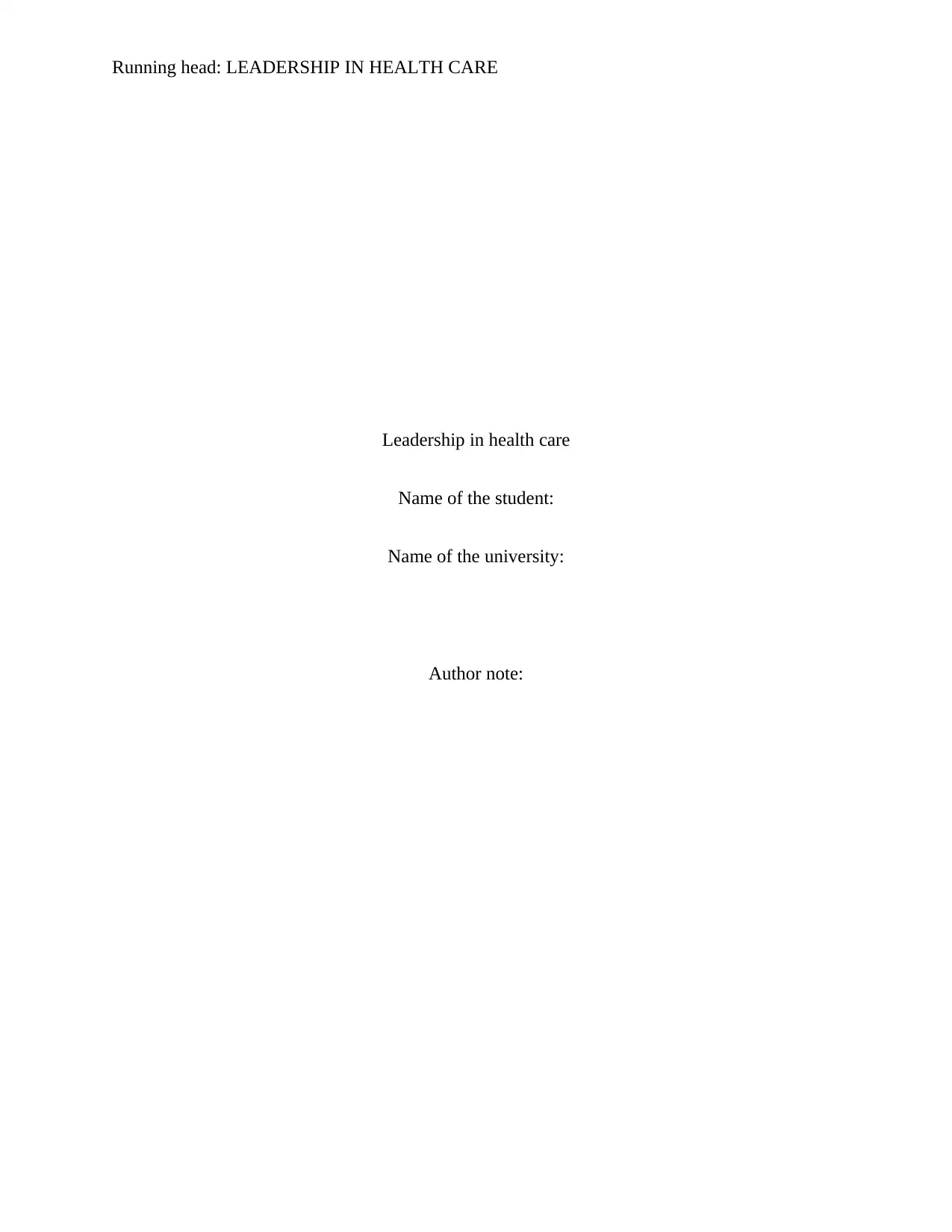
Running head: LEADERSHIP IN HEALTH CARE
Leadership in health care
Name of the student:
Name of the university:
Author note:
Leadership in health care
Name of the student:
Name of the university:
Author note:
Paraphrase This Document
Need a fresh take? Get an instant paraphrase of this document with our AI Paraphraser
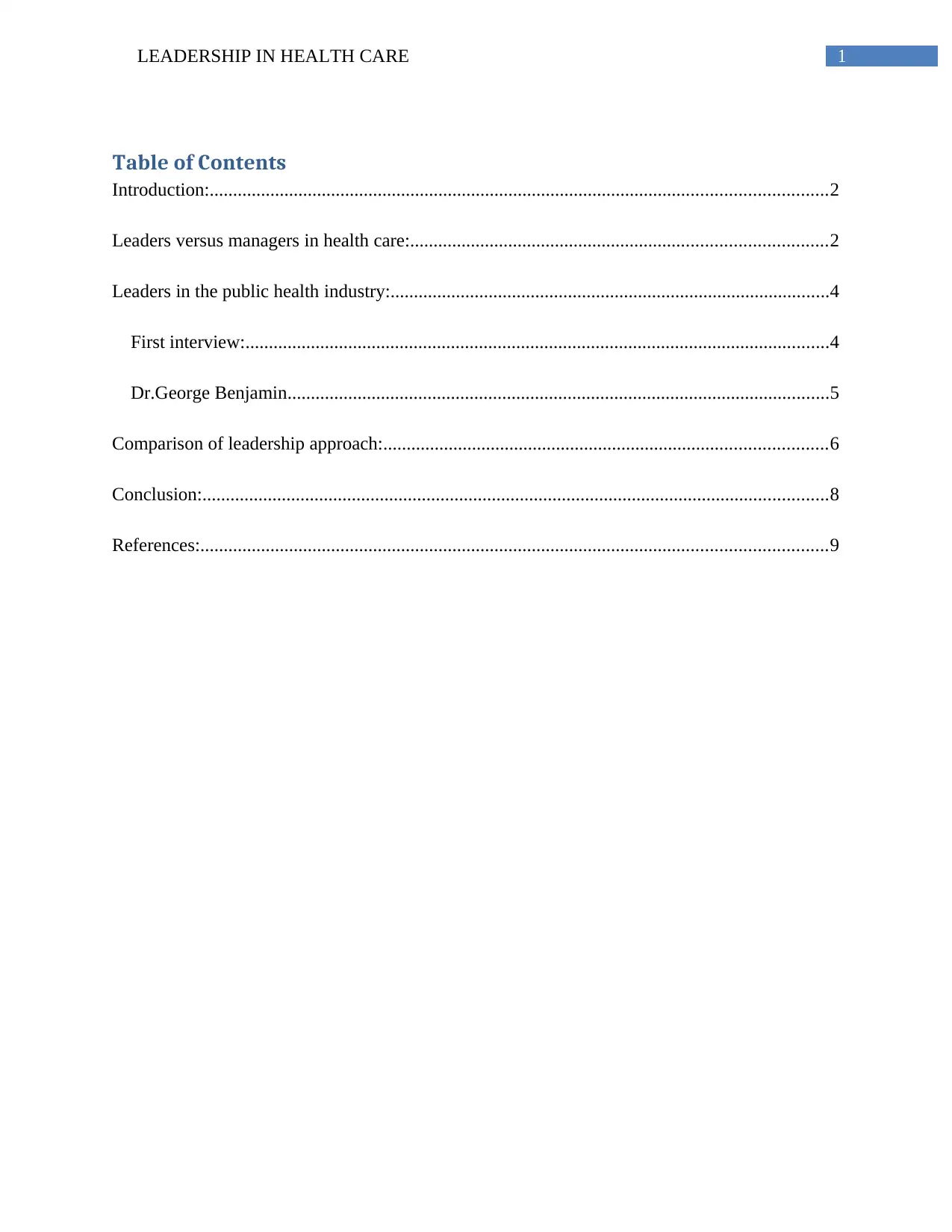
1LEADERSHIP IN HEALTH CARE
Table of Contents
Introduction:....................................................................................................................................2
Leaders versus managers in health care:.........................................................................................2
Leaders in the public health industry:..............................................................................................4
First interview:.............................................................................................................................4
Dr.George Benjamin....................................................................................................................5
Comparison of leadership approach:...............................................................................................6
Conclusion:......................................................................................................................................8
References:......................................................................................................................................9
Table of Contents
Introduction:....................................................................................................................................2
Leaders versus managers in health care:.........................................................................................2
Leaders in the public health industry:..............................................................................................4
First interview:.............................................................................................................................4
Dr.George Benjamin....................................................................................................................5
Comparison of leadership approach:...............................................................................................6
Conclusion:......................................................................................................................................8
References:......................................................................................................................................9
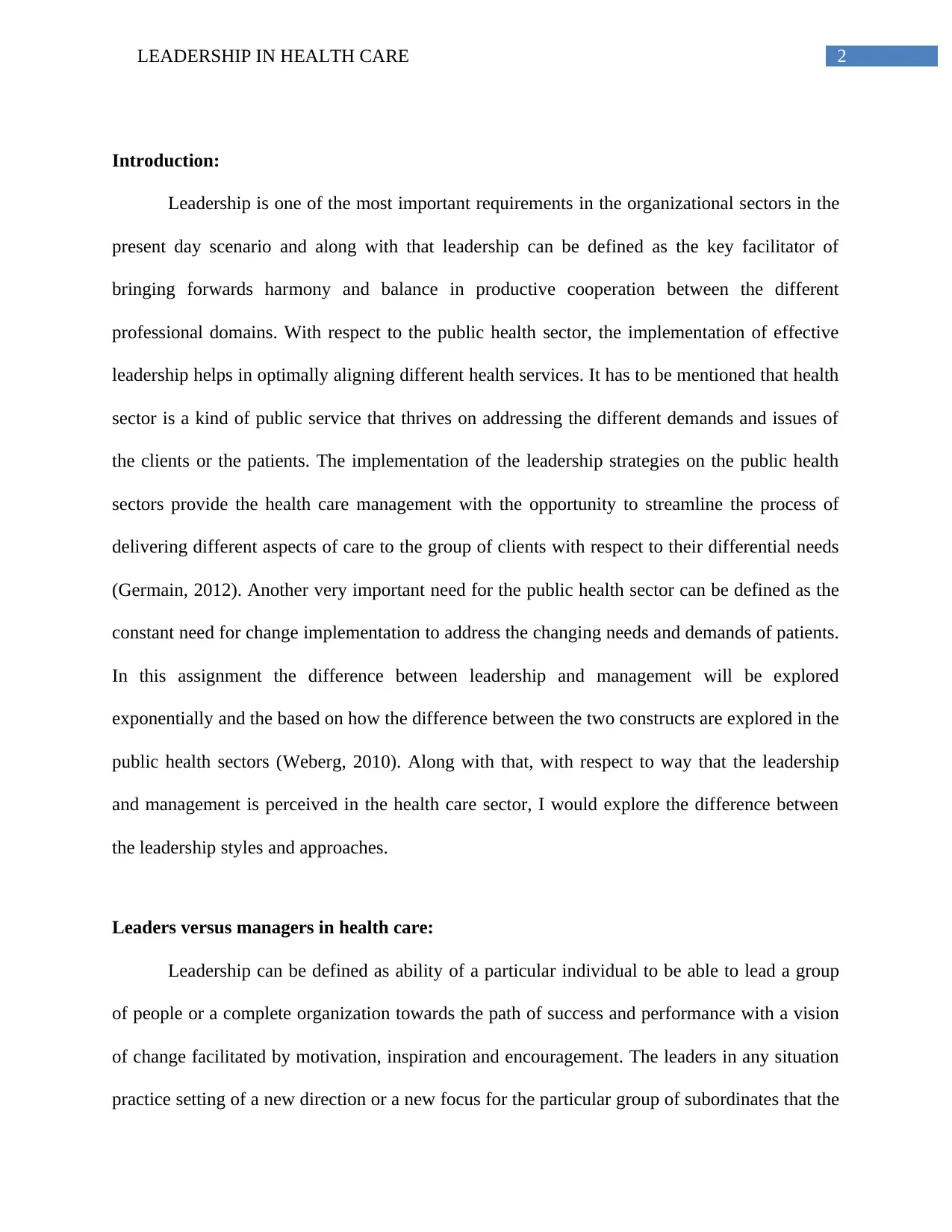
2LEADERSHIP IN HEALTH CARE
Introduction:
Leadership is one of the most important requirements in the organizational sectors in the
present day scenario and along with that leadership can be defined as the key facilitator of
bringing forwards harmony and balance in productive cooperation between the different
professional domains. With respect to the public health sector, the implementation of effective
leadership helps in optimally aligning different health services. It has to be mentioned that health
sector is a kind of public service that thrives on addressing the different demands and issues of
the clients or the patients. The implementation of the leadership strategies on the public health
sectors provide the health care management with the opportunity to streamline the process of
delivering different aspects of care to the group of clients with respect to their differential needs
(Germain, 2012). Another very important need for the public health sector can be defined as the
constant need for change implementation to address the changing needs and demands of patients.
In this assignment the difference between leadership and management will be explored
exponentially and the based on how the difference between the two constructs are explored in the
public health sectors (Weberg, 2010). Along with that, with respect to way that the leadership
and management is perceived in the health care sector, I would explore the difference between
the leadership styles and approaches.
Leaders versus managers in health care:
Leadership can be defined as ability of a particular individual to be able to lead a group
of people or a complete organization towards the path of success and performance with a vision
of change facilitated by motivation, inspiration and encouragement. The leaders in any situation
practice setting of a new direction or a new focus for the particular group of subordinates that the
Introduction:
Leadership is one of the most important requirements in the organizational sectors in the
present day scenario and along with that leadership can be defined as the key facilitator of
bringing forwards harmony and balance in productive cooperation between the different
professional domains. With respect to the public health sector, the implementation of effective
leadership helps in optimally aligning different health services. It has to be mentioned that health
sector is a kind of public service that thrives on addressing the different demands and issues of
the clients or the patients. The implementation of the leadership strategies on the public health
sectors provide the health care management with the opportunity to streamline the process of
delivering different aspects of care to the group of clients with respect to their differential needs
(Germain, 2012). Another very important need for the public health sector can be defined as the
constant need for change implementation to address the changing needs and demands of patients.
In this assignment the difference between leadership and management will be explored
exponentially and the based on how the difference between the two constructs are explored in the
public health sectors (Weberg, 2010). Along with that, with respect to way that the leadership
and management is perceived in the health care sector, I would explore the difference between
the leadership styles and approaches.
Leaders versus managers in health care:
Leadership can be defined as ability of a particular individual to be able to lead a group
of people or a complete organization towards the path of success and performance with a vision
of change facilitated by motivation, inspiration and encouragement. The leaders in any situation
practice setting of a new direction or a new focus for the particular group of subordinates that the
You're viewing a preview
Unlock full access by subscribing today!
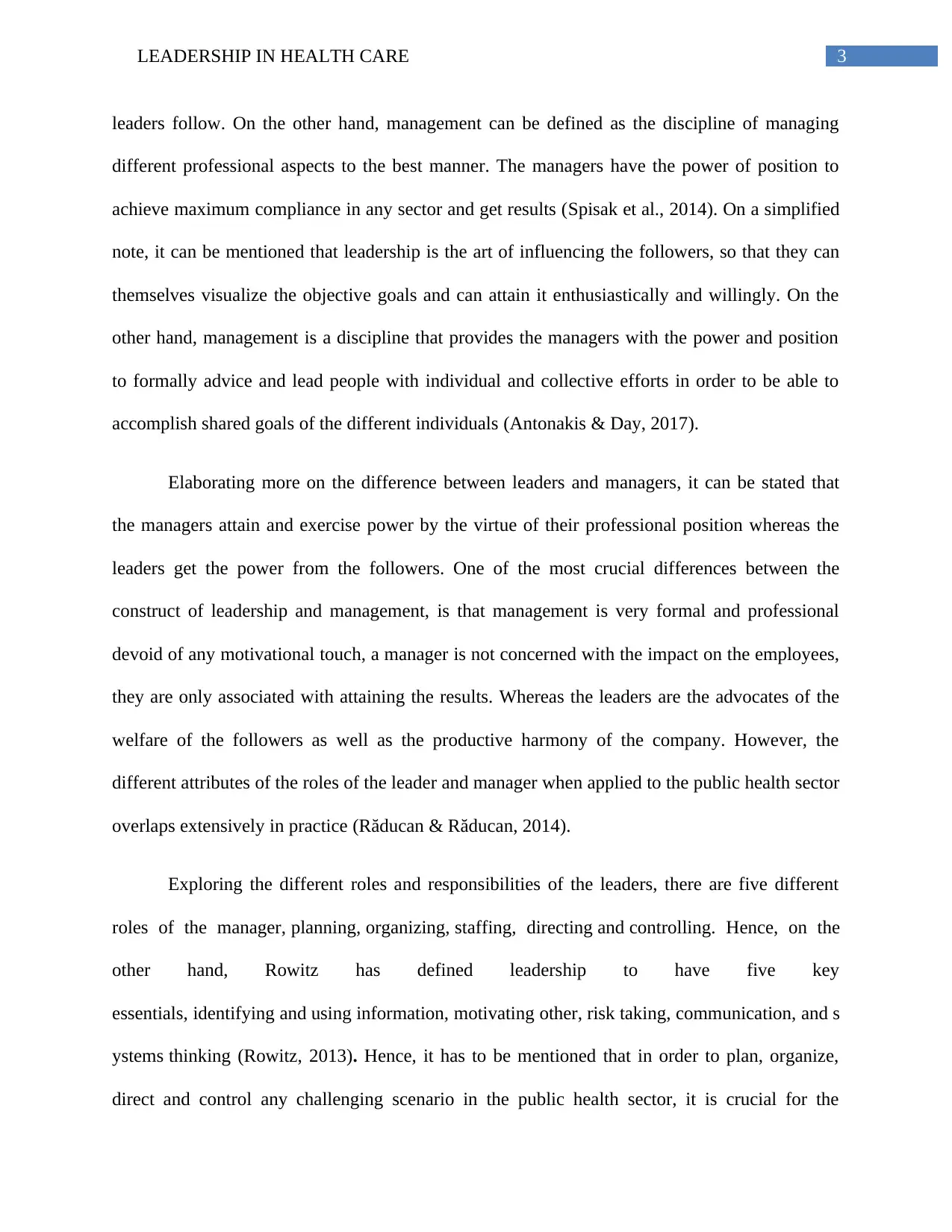
3LEADERSHIP IN HEALTH CARE
leaders follow. On the other hand, management can be defined as the discipline of managing
different professional aspects to the best manner. The managers have the power of position to
achieve maximum compliance in any sector and get results (Spisak et al., 2014). On a simplified
note, it can be mentioned that leadership is the art of influencing the followers, so that they can
themselves visualize the objective goals and can attain it enthusiastically and willingly. On the
other hand, management is a discipline that provides the managers with the power and position
to formally advice and lead people with individual and collective efforts in order to be able to
accomplish shared goals of the different individuals (Antonakis & Day, 2017).
Elaborating more on the difference between leaders and managers, it can be stated that
the managers attain and exercise power by the virtue of their professional position whereas the
leaders get the power from the followers. One of the most crucial differences between the
construct of leadership and management, is that management is very formal and professional
devoid of any motivational touch, a manager is not concerned with the impact on the employees,
they are only associated with attaining the results. Whereas the leaders are the advocates of the
welfare of the followers as well as the productive harmony of the company. However, the
different attributes of the roles of the leader and manager when applied to the public health sector
overlaps extensively in practice (Răducan & Răducan, 2014).
Exploring the different roles and responsibilities of the leaders, there are five different
roles of the manager, planning, organizing, staffing, directing and controlling. Hence, on the
other hand, Rowitz has defined leadership to have five key
essentials, identifying and using information, motivating other, risk taking, communication, and s
ystems thinking (Rowitz, 2013). Hence, it has to be mentioned that in order to plan, organize,
direct and control any challenging scenario in the public health sector, it is crucial for the
leaders follow. On the other hand, management can be defined as the discipline of managing
different professional aspects to the best manner. The managers have the power of position to
achieve maximum compliance in any sector and get results (Spisak et al., 2014). On a simplified
note, it can be mentioned that leadership is the art of influencing the followers, so that they can
themselves visualize the objective goals and can attain it enthusiastically and willingly. On the
other hand, management is a discipline that provides the managers with the power and position
to formally advice and lead people with individual and collective efforts in order to be able to
accomplish shared goals of the different individuals (Antonakis & Day, 2017).
Elaborating more on the difference between leaders and managers, it can be stated that
the managers attain and exercise power by the virtue of their professional position whereas the
leaders get the power from the followers. One of the most crucial differences between the
construct of leadership and management, is that management is very formal and professional
devoid of any motivational touch, a manager is not concerned with the impact on the employees,
they are only associated with attaining the results. Whereas the leaders are the advocates of the
welfare of the followers as well as the productive harmony of the company. However, the
different attributes of the roles of the leader and manager when applied to the public health sector
overlaps extensively in practice (Răducan & Răducan, 2014).
Exploring the different roles and responsibilities of the leaders, there are five different
roles of the manager, planning, organizing, staffing, directing and controlling. Hence, on the
other hand, Rowitz has defined leadership to have five key
essentials, identifying and using information, motivating other, risk taking, communication, and s
ystems thinking (Rowitz, 2013). Hence, it has to be mentioned that in order to plan, organize,
direct and control any challenging scenario in the public health sector, it is crucial for the
Paraphrase This Document
Need a fresh take? Get an instant paraphrase of this document with our AI Paraphraser
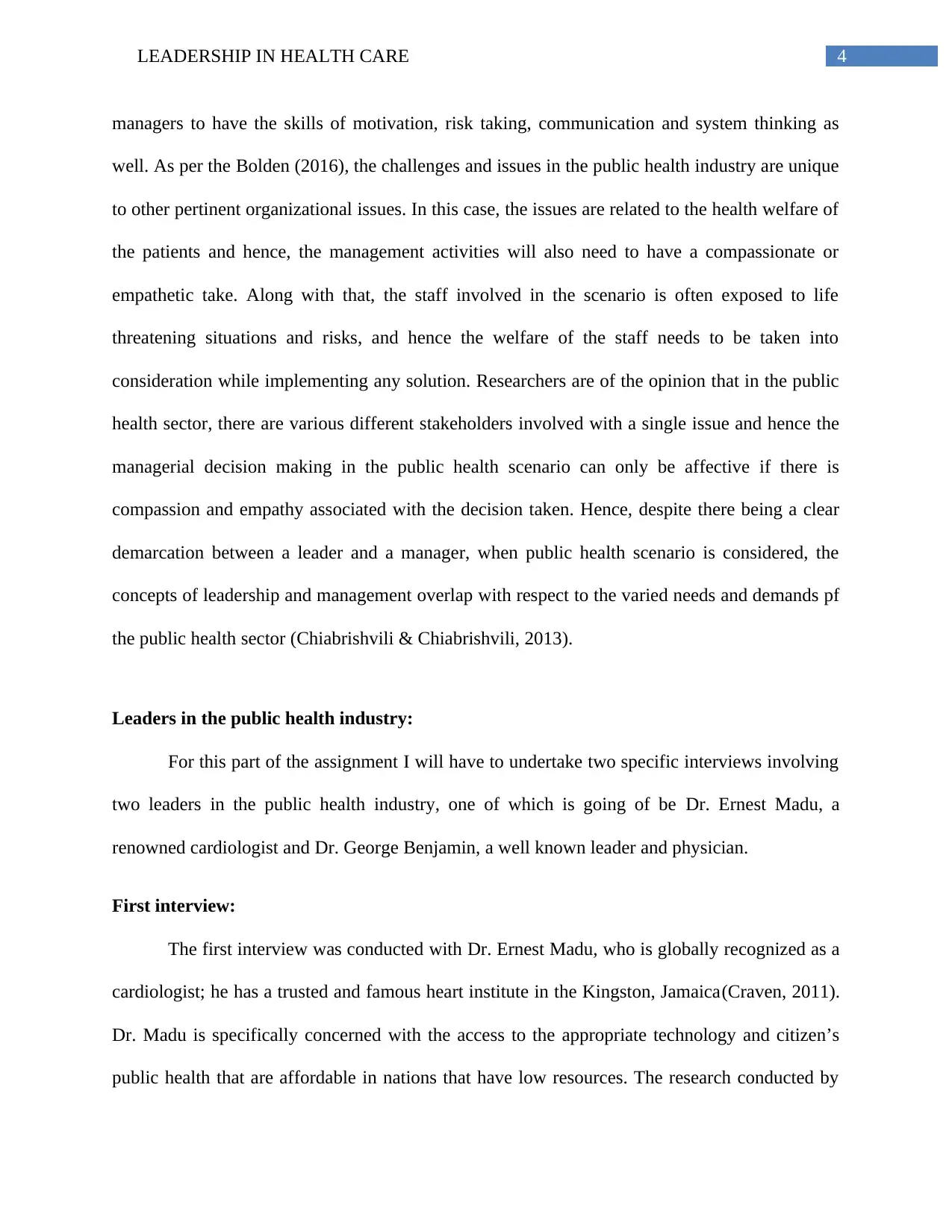
4LEADERSHIP IN HEALTH CARE
managers to have the skills of motivation, risk taking, communication and system thinking as
well. As per the Bolden (2016), the challenges and issues in the public health industry are unique
to other pertinent organizational issues. In this case, the issues are related to the health welfare of
the patients and hence, the management activities will also need to have a compassionate or
empathetic take. Along with that, the staff involved in the scenario is often exposed to life
threatening situations and risks, and hence the welfare of the staff needs to be taken into
consideration while implementing any solution. Researchers are of the opinion that in the public
health sector, there are various different stakeholders involved with a single issue and hence the
managerial decision making in the public health scenario can only be affective if there is
compassion and empathy associated with the decision taken. Hence, despite there being a clear
demarcation between a leader and a manager, when public health scenario is considered, the
concepts of leadership and management overlap with respect to the varied needs and demands pf
the public health sector (Chiabrishvili & Chiabrishvili, 2013).
Leaders in the public health industry:
For this part of the assignment I will have to undertake two specific interviews involving
two leaders in the public health industry, one of which is going of be Dr. Ernest Madu, a
renowned cardiologist and Dr. George Benjamin, a well known leader and physician.
First interview:
The first interview was conducted with Dr. Ernest Madu, who is globally recognized as a
cardiologist; he has a trusted and famous heart institute in the Kingston, Jamaica(Craven, 2011).
Dr. Madu is specifically concerned with the access to the appropriate technology and citizen’s
public health that are affordable in nations that have low resources. The research conducted by
managers to have the skills of motivation, risk taking, communication and system thinking as
well. As per the Bolden (2016), the challenges and issues in the public health industry are unique
to other pertinent organizational issues. In this case, the issues are related to the health welfare of
the patients and hence, the management activities will also need to have a compassionate or
empathetic take. Along with that, the staff involved in the scenario is often exposed to life
threatening situations and risks, and hence the welfare of the staff needs to be taken into
consideration while implementing any solution. Researchers are of the opinion that in the public
health sector, there are various different stakeholders involved with a single issue and hence the
managerial decision making in the public health scenario can only be affective if there is
compassion and empathy associated with the decision taken. Hence, despite there being a clear
demarcation between a leader and a manager, when public health scenario is considered, the
concepts of leadership and management overlap with respect to the varied needs and demands pf
the public health sector (Chiabrishvili & Chiabrishvili, 2013).
Leaders in the public health industry:
For this part of the assignment I will have to undertake two specific interviews involving
two leaders in the public health industry, one of which is going of be Dr. Ernest Madu, a
renowned cardiologist and Dr. George Benjamin, a well known leader and physician.
First interview:
The first interview was conducted with Dr. Ernest Madu, who is globally recognized as a
cardiologist; he has a trusted and famous heart institute in the Kingston, Jamaica(Craven, 2011).
Dr. Madu is specifically concerned with the access to the appropriate technology and citizen’s
public health that are affordable in nations that have low resources. The research conducted by
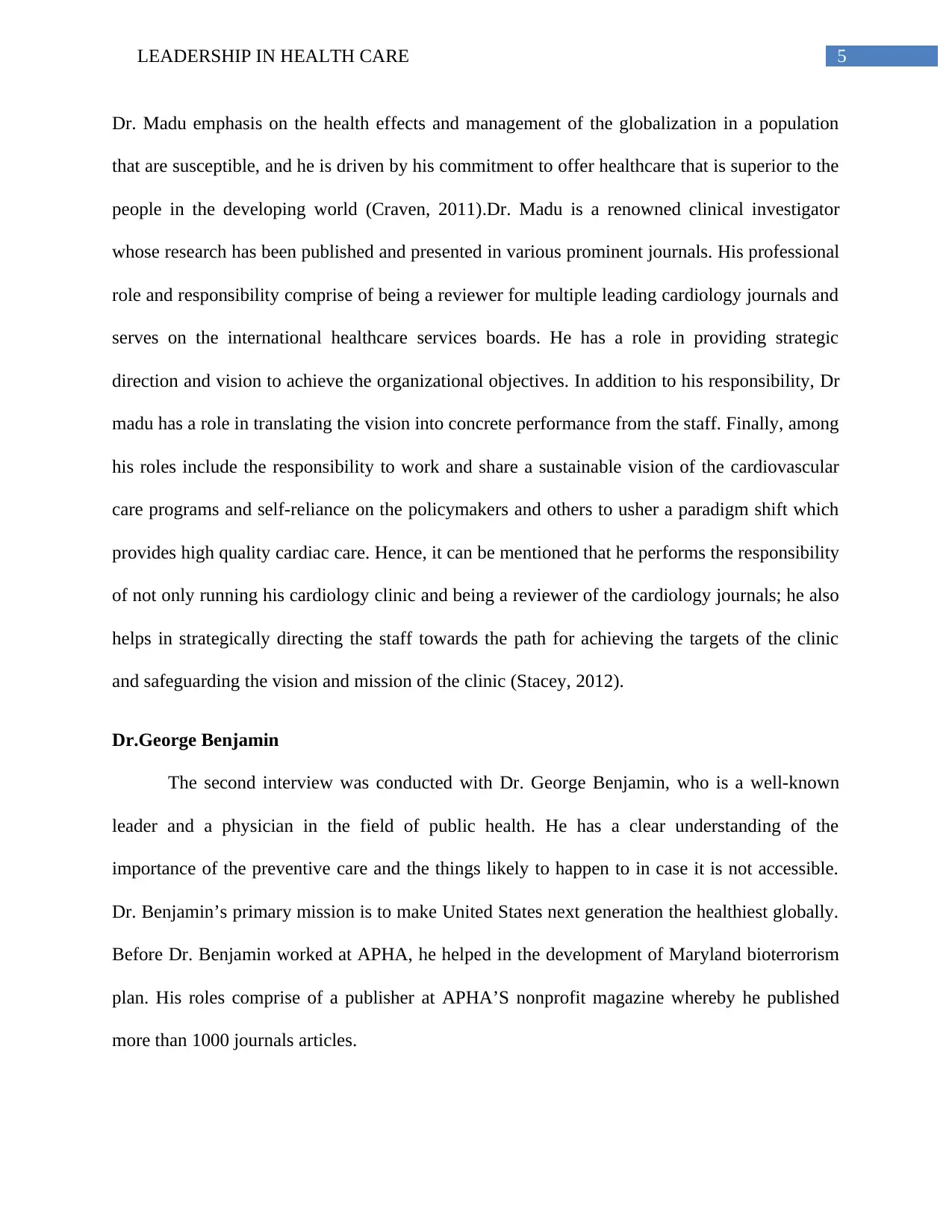
5LEADERSHIP IN HEALTH CARE
Dr. Madu emphasis on the health effects and management of the globalization in a population
that are susceptible, and he is driven by his commitment to offer healthcare that is superior to the
people in the developing world (Craven, 2011).Dr. Madu is a renowned clinical investigator
whose research has been published and presented in various prominent journals. His professional
role and responsibility comprise of being a reviewer for multiple leading cardiology journals and
serves on the international healthcare services boards. He has a role in providing strategic
direction and vision to achieve the organizational objectives. In addition to his responsibility, Dr
madu has a role in translating the vision into concrete performance from the staff. Finally, among
his roles include the responsibility to work and share a sustainable vision of the cardiovascular
care programs and self-reliance on the policymakers and others to usher a paradigm shift which
provides high quality cardiac care. Hence, it can be mentioned that he performs the responsibility
of not only running his cardiology clinic and being a reviewer of the cardiology journals; he also
helps in strategically directing the staff towards the path for achieving the targets of the clinic
and safeguarding the vision and mission of the clinic (Stacey, 2012).
Dr.George Benjamin
The second interview was conducted with Dr. George Benjamin, who is a well-known
leader and a physician in the field of public health. He has a clear understanding of the
importance of the preventive care and the things likely to happen to in case it is not accessible.
Dr. Benjamin’s primary mission is to make United States next generation the healthiest globally.
Before Dr. Benjamin worked at APHA, he helped in the development of Maryland bioterrorism
plan. His roles comprise of a publisher at APHA’S nonprofit magazine whereby he published
more than 1000 journals articles.
Dr. Madu emphasis on the health effects and management of the globalization in a population
that are susceptible, and he is driven by his commitment to offer healthcare that is superior to the
people in the developing world (Craven, 2011).Dr. Madu is a renowned clinical investigator
whose research has been published and presented in various prominent journals. His professional
role and responsibility comprise of being a reviewer for multiple leading cardiology journals and
serves on the international healthcare services boards. He has a role in providing strategic
direction and vision to achieve the organizational objectives. In addition to his responsibility, Dr
madu has a role in translating the vision into concrete performance from the staff. Finally, among
his roles include the responsibility to work and share a sustainable vision of the cardiovascular
care programs and self-reliance on the policymakers and others to usher a paradigm shift which
provides high quality cardiac care. Hence, it can be mentioned that he performs the responsibility
of not only running his cardiology clinic and being a reviewer of the cardiology journals; he also
helps in strategically directing the staff towards the path for achieving the targets of the clinic
and safeguarding the vision and mission of the clinic (Stacey, 2012).
Dr.George Benjamin
The second interview was conducted with Dr. George Benjamin, who is a well-known
leader and a physician in the field of public health. He has a clear understanding of the
importance of the preventive care and the things likely to happen to in case it is not accessible.
Dr. Benjamin’s primary mission is to make United States next generation the healthiest globally.
Before Dr. Benjamin worked at APHA, he helped in the development of Maryland bioterrorism
plan. His roles comprise of a publisher at APHA’S nonprofit magazine whereby he published
more than 1000 journals articles.
You're viewing a preview
Unlock full access by subscribing today!
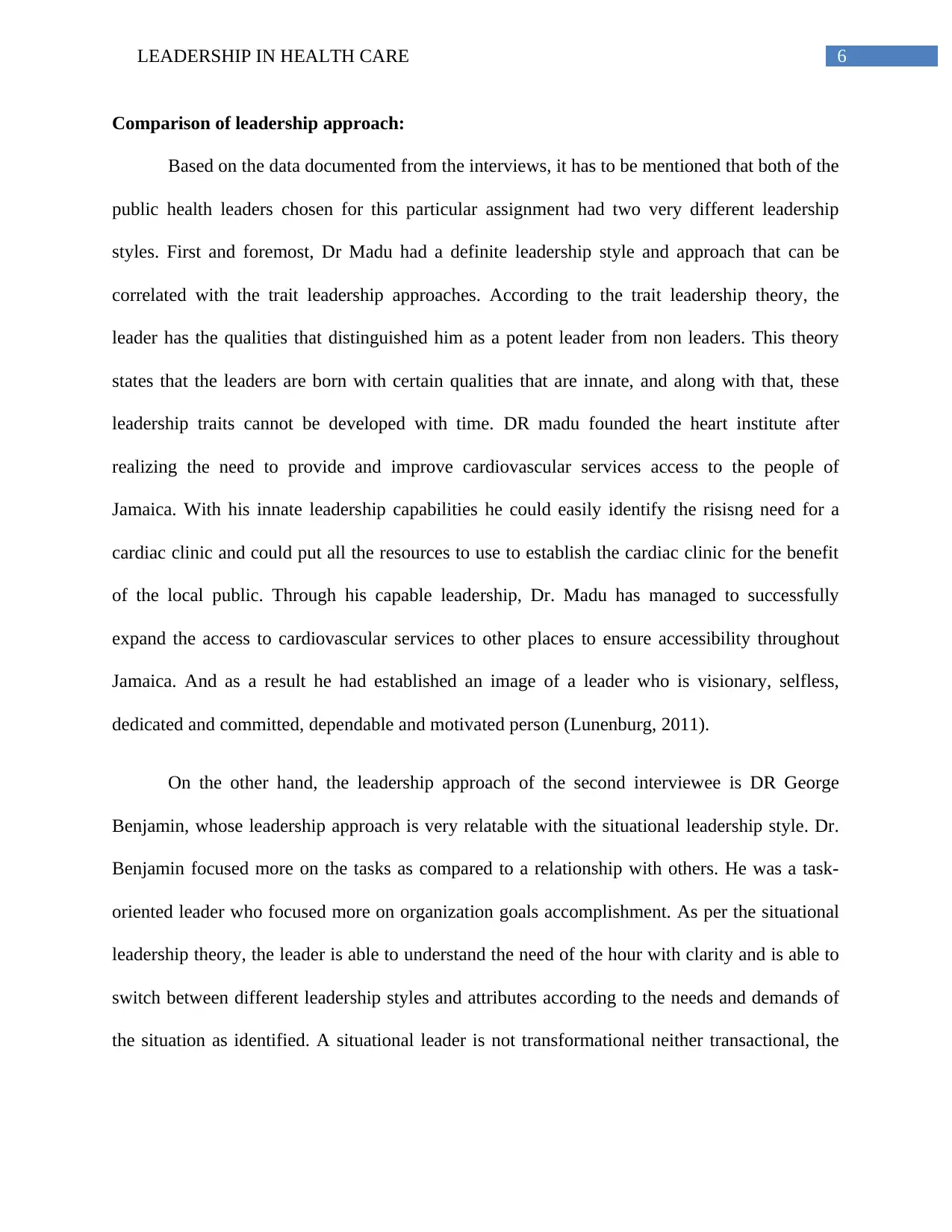
6LEADERSHIP IN HEALTH CARE
Comparison of leadership approach:
Based on the data documented from the interviews, it has to be mentioned that both of the
public health leaders chosen for this particular assignment had two very different leadership
styles. First and foremost, Dr Madu had a definite leadership style and approach that can be
correlated with the trait leadership approaches. According to the trait leadership theory, the
leader has the qualities that distinguished him as a potent leader from non leaders. This theory
states that the leaders are born with certain qualities that are innate, and along with that, these
leadership traits cannot be developed with time. DR madu founded the heart institute after
realizing the need to provide and improve cardiovascular services access to the people of
Jamaica. With his innate leadership capabilities he could easily identify the risisng need for a
cardiac clinic and could put all the resources to use to establish the cardiac clinic for the benefit
of the local public. Through his capable leadership, Dr. Madu has managed to successfully
expand the access to cardiovascular services to other places to ensure accessibility throughout
Jamaica. And as a result he had established an image of a leader who is visionary, selfless,
dedicated and committed, dependable and motivated person (Lunenburg, 2011).
On the other hand, the leadership approach of the second interviewee is DR George
Benjamin, whose leadership approach is very relatable with the situational leadership style. Dr.
Benjamin focused more on the tasks as compared to a relationship with others. He was a task-
oriented leader who focused more on organization goals accomplishment. As per the situational
leadership theory, the leader is able to understand the need of the hour with clarity and is able to
switch between different leadership styles and attributes according to the needs and demands of
the situation as identified. A situational leader is not transformational neither transactional, the
Comparison of leadership approach:
Based on the data documented from the interviews, it has to be mentioned that both of the
public health leaders chosen for this particular assignment had two very different leadership
styles. First and foremost, Dr Madu had a definite leadership style and approach that can be
correlated with the trait leadership approaches. According to the trait leadership theory, the
leader has the qualities that distinguished him as a potent leader from non leaders. This theory
states that the leaders are born with certain qualities that are innate, and along with that, these
leadership traits cannot be developed with time. DR madu founded the heart institute after
realizing the need to provide and improve cardiovascular services access to the people of
Jamaica. With his innate leadership capabilities he could easily identify the risisng need for a
cardiac clinic and could put all the resources to use to establish the cardiac clinic for the benefit
of the local public. Through his capable leadership, Dr. Madu has managed to successfully
expand the access to cardiovascular services to other places to ensure accessibility throughout
Jamaica. And as a result he had established an image of a leader who is visionary, selfless,
dedicated and committed, dependable and motivated person (Lunenburg, 2011).
On the other hand, the leadership approach of the second interviewee is DR George
Benjamin, whose leadership approach is very relatable with the situational leadership style. Dr.
Benjamin focused more on the tasks as compared to a relationship with others. He was a task-
oriented leader who focused more on organization goals accomplishment. As per the situational
leadership theory, the leader is able to understand the need of the hour with clarity and is able to
switch between different leadership styles and attributes according to the needs and demands of
the situation as identified. A situational leader is not transformational neither transactional, the
Paraphrase This Document
Need a fresh take? Get an instant paraphrase of this document with our AI Paraphraser
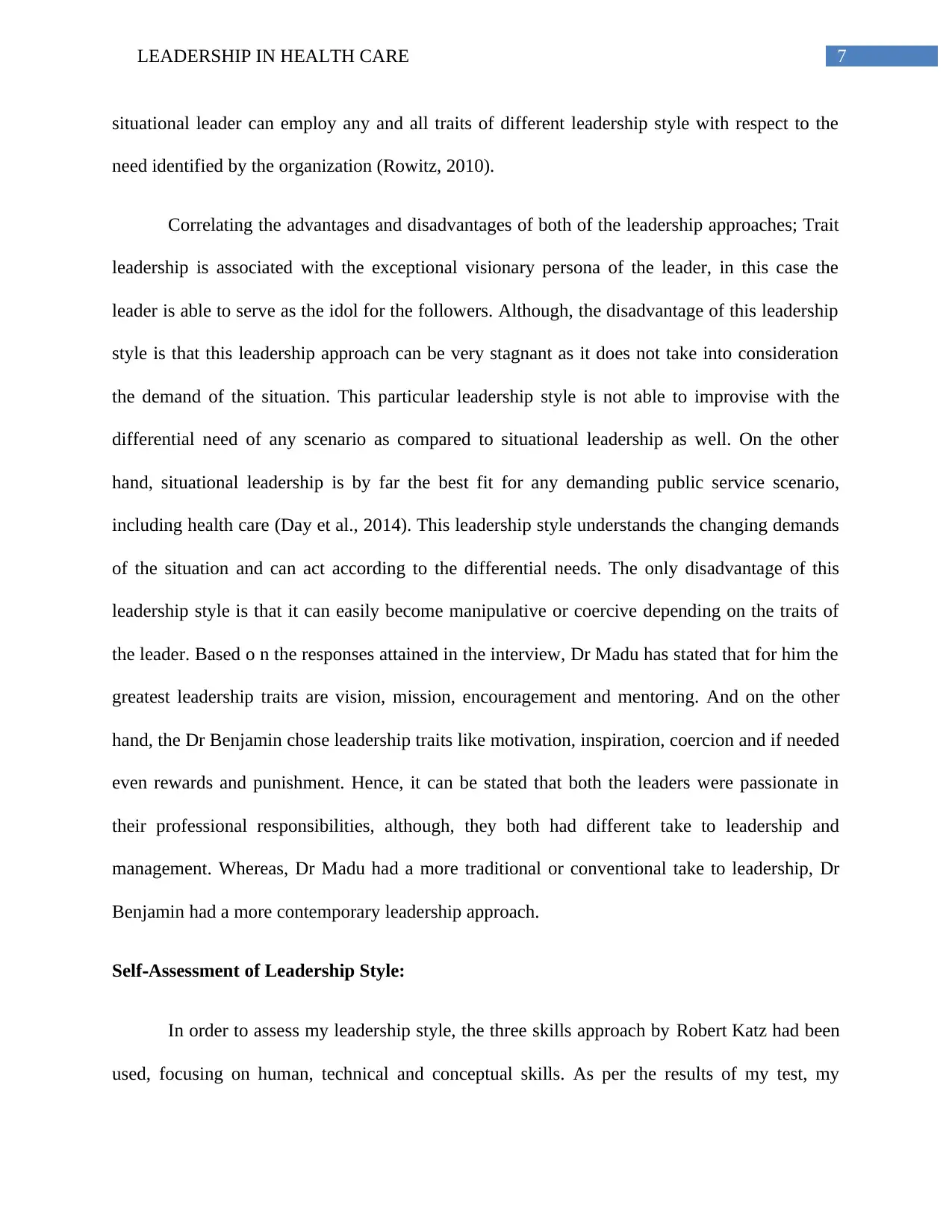
7LEADERSHIP IN HEALTH CARE
situational leader can employ any and all traits of different leadership style with respect to the
need identified by the organization (Rowitz, 2010).
Correlating the advantages and disadvantages of both of the leadership approaches; Trait
leadership is associated with the exceptional visionary persona of the leader, in this case the
leader is able to serve as the idol for the followers. Although, the disadvantage of this leadership
style is that this leadership approach can be very stagnant as it does not take into consideration
the demand of the situation. This particular leadership style is not able to improvise with the
differential need of any scenario as compared to situational leadership as well. On the other
hand, situational leadership is by far the best fit for any demanding public service scenario,
including health care (Day et al., 2014). This leadership style understands the changing demands
of the situation and can act according to the differential needs. The only disadvantage of this
leadership style is that it can easily become manipulative or coercive depending on the traits of
the leader. Based o n the responses attained in the interview, Dr Madu has stated that for him the
greatest leadership traits are vision, mission, encouragement and mentoring. And on the other
hand, the Dr Benjamin chose leadership traits like motivation, inspiration, coercion and if needed
even rewards and punishment. Hence, it can be stated that both the leaders were passionate in
their professional responsibilities, although, they both had different take to leadership and
management. Whereas, Dr Madu had a more traditional or conventional take to leadership, Dr
Benjamin had a more contemporary leadership approach.
Self‐Assessment of Leadership Style:
In order to assess my leadership style, the three skills approach by Robert Katz had been
used, focusing on human, technical and conceptual skills. As per the results of my test, my
situational leader can employ any and all traits of different leadership style with respect to the
need identified by the organization (Rowitz, 2010).
Correlating the advantages and disadvantages of both of the leadership approaches; Trait
leadership is associated with the exceptional visionary persona of the leader, in this case the
leader is able to serve as the idol for the followers. Although, the disadvantage of this leadership
style is that this leadership approach can be very stagnant as it does not take into consideration
the demand of the situation. This particular leadership style is not able to improvise with the
differential need of any scenario as compared to situational leadership as well. On the other
hand, situational leadership is by far the best fit for any demanding public service scenario,
including health care (Day et al., 2014). This leadership style understands the changing demands
of the situation and can act according to the differential needs. The only disadvantage of this
leadership style is that it can easily become manipulative or coercive depending on the traits of
the leader. Based o n the responses attained in the interview, Dr Madu has stated that for him the
greatest leadership traits are vision, mission, encouragement and mentoring. And on the other
hand, the Dr Benjamin chose leadership traits like motivation, inspiration, coercion and if needed
even rewards and punishment. Hence, it can be stated that both the leaders were passionate in
their professional responsibilities, although, they both had different take to leadership and
management. Whereas, Dr Madu had a more traditional or conventional take to leadership, Dr
Benjamin had a more contemporary leadership approach.
Self‐Assessment of Leadership Style:
In order to assess my leadership style, the three skills approach by Robert Katz had been
used, focusing on human, technical and conceptual skills. As per the results of my test, my
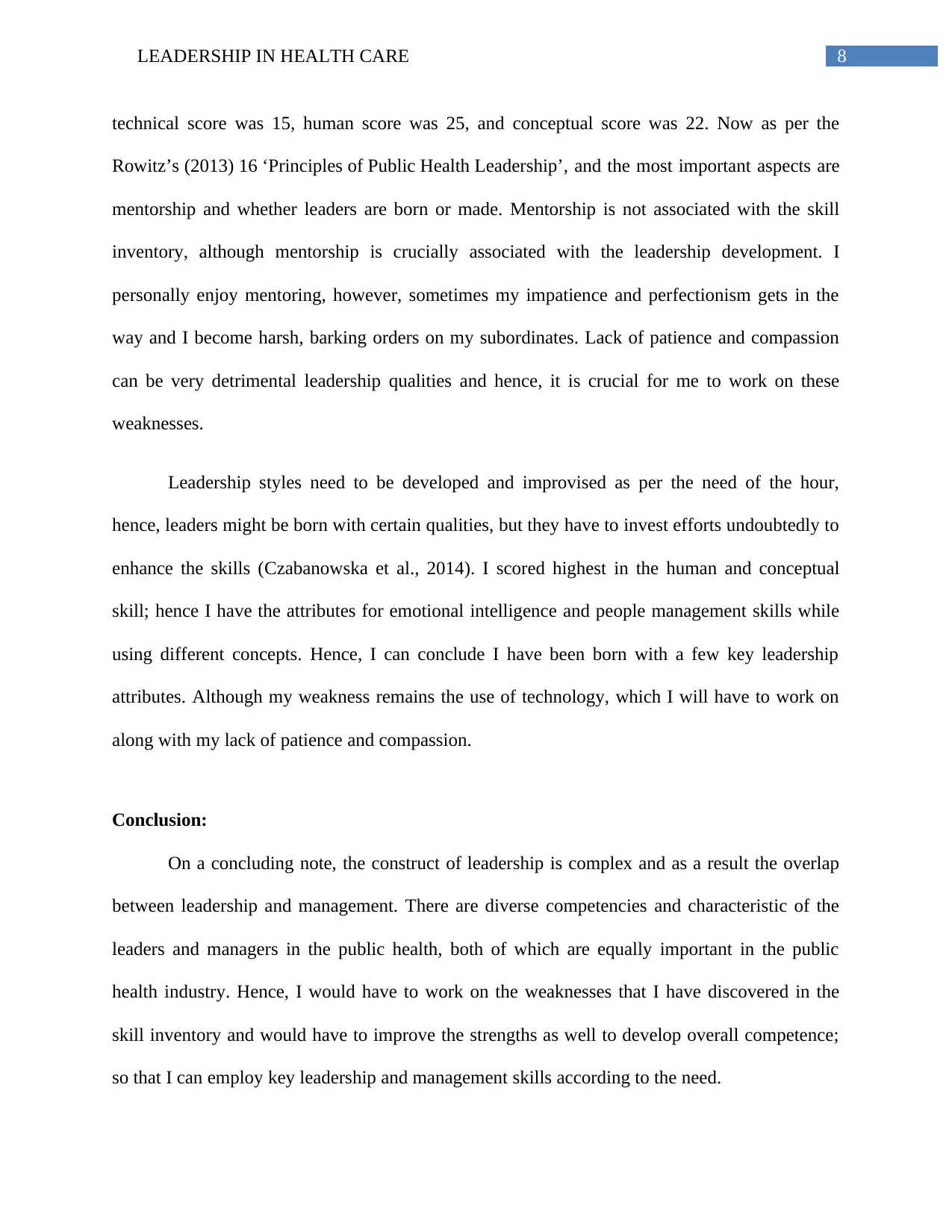
8LEADERSHIP IN HEALTH CARE
technical score was 15, human score was 25, and conceptual score was 22. Now as per the
Rowitz’s (2013) 16 ‘Principles of Public Health Leadership’, and the most important aspects are
mentorship and whether leaders are born or made. Mentorship is not associated with the skill
inventory, although mentorship is crucially associated with the leadership development. I
personally enjoy mentoring, however, sometimes my impatience and perfectionism gets in the
way and I become harsh, barking orders on my subordinates. Lack of patience and compassion
can be very detrimental leadership qualities and hence, it is crucial for me to work on these
weaknesses.
Leadership styles need to be developed and improvised as per the need of the hour,
hence, leaders might be born with certain qualities, but they have to invest efforts undoubtedly to
enhance the skills (Czabanowska et al., 2014). I scored highest in the human and conceptual
skill; hence I have the attributes for emotional intelligence and people management skills while
using different concepts. Hence, I can conclude I have been born with a few key leadership
attributes. Although my weakness remains the use of technology, which I will have to work on
along with my lack of patience and compassion.
Conclusion:
On a concluding note, the construct of leadership is complex and as a result the overlap
between leadership and management. There are diverse competencies and characteristic of the
leaders and managers in the public health, both of which are equally important in the public
health industry. Hence, I would have to work on the weaknesses that I have discovered in the
skill inventory and would have to improve the strengths as well to develop overall competence;
so that I can employ key leadership and management skills according to the need.
technical score was 15, human score was 25, and conceptual score was 22. Now as per the
Rowitz’s (2013) 16 ‘Principles of Public Health Leadership’, and the most important aspects are
mentorship and whether leaders are born or made. Mentorship is not associated with the skill
inventory, although mentorship is crucially associated with the leadership development. I
personally enjoy mentoring, however, sometimes my impatience and perfectionism gets in the
way and I become harsh, barking orders on my subordinates. Lack of patience and compassion
can be very detrimental leadership qualities and hence, it is crucial for me to work on these
weaknesses.
Leadership styles need to be developed and improvised as per the need of the hour,
hence, leaders might be born with certain qualities, but they have to invest efforts undoubtedly to
enhance the skills (Czabanowska et al., 2014). I scored highest in the human and conceptual
skill; hence I have the attributes for emotional intelligence and people management skills while
using different concepts. Hence, I can conclude I have been born with a few key leadership
attributes. Although my weakness remains the use of technology, which I will have to work on
along with my lack of patience and compassion.
Conclusion:
On a concluding note, the construct of leadership is complex and as a result the overlap
between leadership and management. There are diverse competencies and characteristic of the
leaders and managers in the public health, both of which are equally important in the public
health industry. Hence, I would have to work on the weaknesses that I have discovered in the
skill inventory and would have to improve the strengths as well to develop overall competence;
so that I can employ key leadership and management skills according to the need.
You're viewing a preview
Unlock full access by subscribing today!
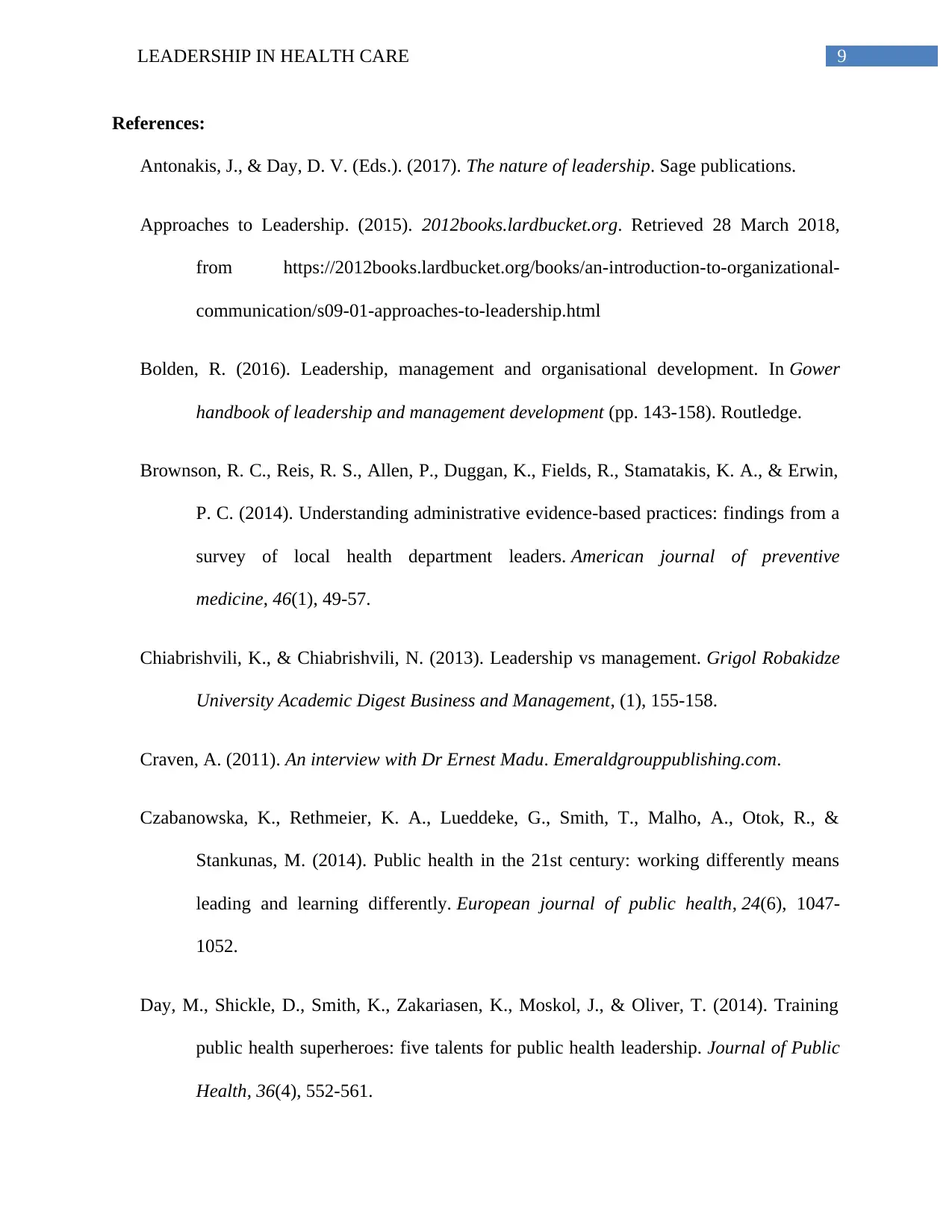
9LEADERSHIP IN HEALTH CARE
References:
Antonakis, J., & Day, D. V. (Eds.). (2017). The nature of leadership. Sage publications.
Approaches to Leadership. (2015). 2012books.lardbucket.org. Retrieved 28 March 2018,
from https://2012books.lardbucket.org/books/an-introduction-to-organizational-
communication/s09-01-approaches-to-leadership.html
Bolden, R. (2016). Leadership, management and organisational development. In Gower
handbook of leadership and management development (pp. 143-158). Routledge.
Brownson, R. C., Reis, R. S., Allen, P., Duggan, K., Fields, R., Stamatakis, K. A., & Erwin,
P. C. (2014). Understanding administrative evidence-based practices: findings from a
survey of local health department leaders. American journal of preventive
medicine, 46(1), 49-57.
Chiabrishvili, K., & Chiabrishvili, N. (2013). Leadership vs management. Grigol Robakidze
University Academic Digest Business and Management, (1), 155-158.
Craven, A. (2011). An interview with Dr Ernest Madu. Emeraldgrouppublishing.com.
Czabanowska, K., Rethmeier, K. A., Lueddeke, G., Smith, T., Malho, A., Otok, R., &
Stankunas, M. (2014). Public health in the 21st century: working differently means
leading and learning differently. European journal of public health, 24(6), 1047-
1052.
Day, M., Shickle, D., Smith, K., Zakariasen, K., Moskol, J., & Oliver, T. (2014). Training
public health superheroes: five talents for public health leadership. Journal of Public
Health, 36(4), 552-561.
References:
Antonakis, J., & Day, D. V. (Eds.). (2017). The nature of leadership. Sage publications.
Approaches to Leadership. (2015). 2012books.lardbucket.org. Retrieved 28 March 2018,
from https://2012books.lardbucket.org/books/an-introduction-to-organizational-
communication/s09-01-approaches-to-leadership.html
Bolden, R. (2016). Leadership, management and organisational development. In Gower
handbook of leadership and management development (pp. 143-158). Routledge.
Brownson, R. C., Reis, R. S., Allen, P., Duggan, K., Fields, R., Stamatakis, K. A., & Erwin,
P. C. (2014). Understanding administrative evidence-based practices: findings from a
survey of local health department leaders. American journal of preventive
medicine, 46(1), 49-57.
Chiabrishvili, K., & Chiabrishvili, N. (2013). Leadership vs management. Grigol Robakidze
University Academic Digest Business and Management, (1), 155-158.
Craven, A. (2011). An interview with Dr Ernest Madu. Emeraldgrouppublishing.com.
Czabanowska, K., Rethmeier, K. A., Lueddeke, G., Smith, T., Malho, A., Otok, R., &
Stankunas, M. (2014). Public health in the 21st century: working differently means
leading and learning differently. European journal of public health, 24(6), 1047-
1052.
Day, M., Shickle, D., Smith, K., Zakariasen, K., Moskol, J., & Oliver, T. (2014). Training
public health superheroes: five talents for public health leadership. Journal of Public
Health, 36(4), 552-561.
Paraphrase This Document
Need a fresh take? Get an instant paraphrase of this document with our AI Paraphraser
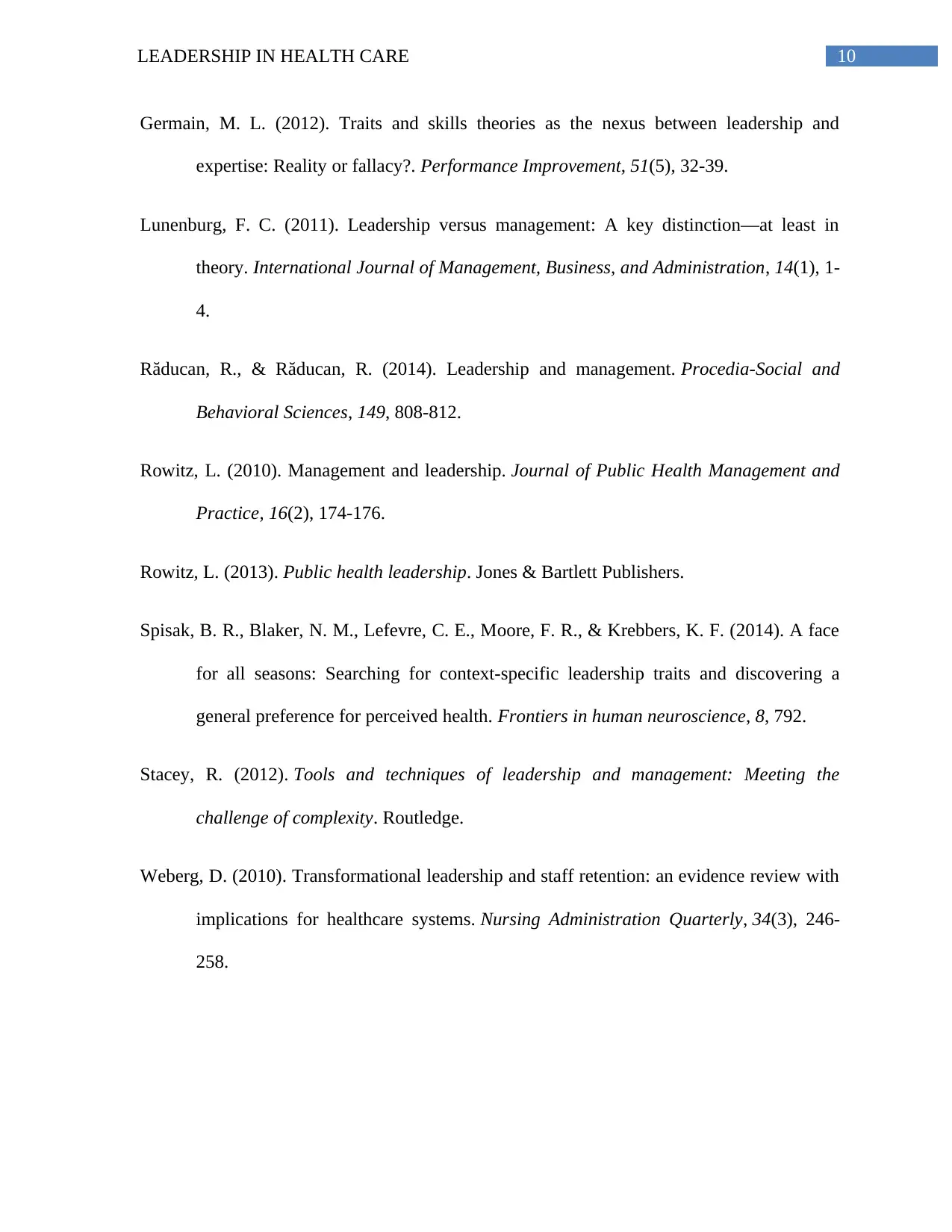
10LEADERSHIP IN HEALTH CARE
Germain, M. L. (2012). Traits and skills theories as the nexus between leadership and
expertise: Reality or fallacy?. Performance Improvement, 51(5), 32-39.
Lunenburg, F. C. (2011). Leadership versus management: A key distinction—at least in
theory. International Journal of Management, Business, and Administration, 14(1), 1-
4.
Răducan, R., & Răducan, R. (2014). Leadership and management. Procedia-Social and
Behavioral Sciences, 149, 808-812.
Rowitz, L. (2010). Management and leadership. Journal of Public Health Management and
Practice, 16(2), 174-176.
Rowitz, L. (2013). Public health leadership. Jones & Bartlett Publishers.
Spisak, B. R., Blaker, N. M., Lefevre, C. E., Moore, F. R., & Krebbers, K. F. (2014). A face
for all seasons: Searching for context-specific leadership traits and discovering a
general preference for perceived health. Frontiers in human neuroscience, 8, 792.
Stacey, R. (2012). Tools and techniques of leadership and management: Meeting the
challenge of complexity. Routledge.
Weberg, D. (2010). Transformational leadership and staff retention: an evidence review with
implications for healthcare systems. Nursing Administration Quarterly, 34(3), 246-
258.
Germain, M. L. (2012). Traits and skills theories as the nexus between leadership and
expertise: Reality or fallacy?. Performance Improvement, 51(5), 32-39.
Lunenburg, F. C. (2011). Leadership versus management: A key distinction—at least in
theory. International Journal of Management, Business, and Administration, 14(1), 1-
4.
Răducan, R., & Răducan, R. (2014). Leadership and management. Procedia-Social and
Behavioral Sciences, 149, 808-812.
Rowitz, L. (2010). Management and leadership. Journal of Public Health Management and
Practice, 16(2), 174-176.
Rowitz, L. (2013). Public health leadership. Jones & Bartlett Publishers.
Spisak, B. R., Blaker, N. M., Lefevre, C. E., Moore, F. R., & Krebbers, K. F. (2014). A face
for all seasons: Searching for context-specific leadership traits and discovering a
general preference for perceived health. Frontiers in human neuroscience, 8, 792.
Stacey, R. (2012). Tools and techniques of leadership and management: Meeting the
challenge of complexity. Routledge.
Weberg, D. (2010). Transformational leadership and staff retention: an evidence review with
implications for healthcare systems. Nursing Administration Quarterly, 34(3), 246-
258.
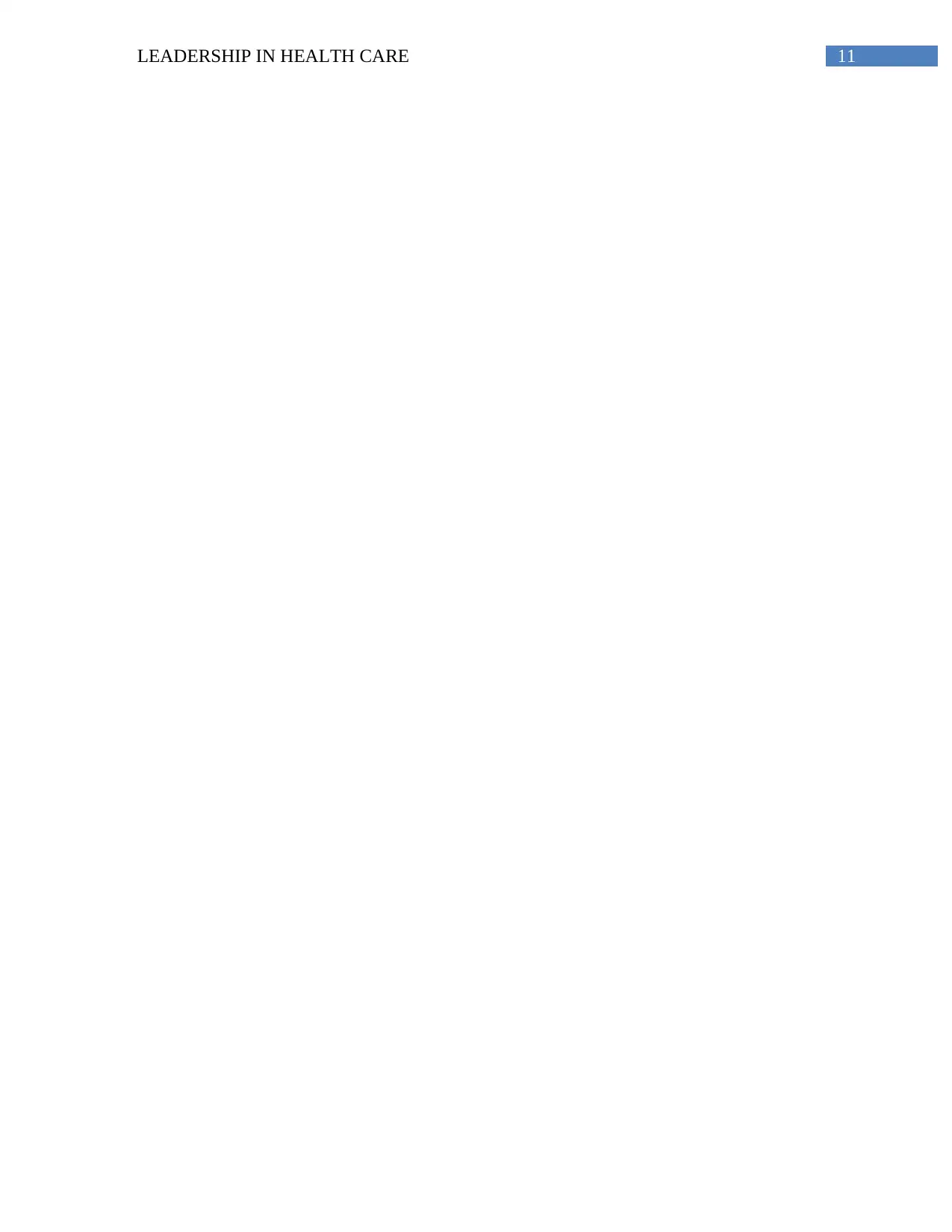
11LEADERSHIP IN HEALTH CARE
You're viewing a preview
Unlock full access by subscribing today!
1 out of 12
Related Documents
Your All-in-One AI-Powered Toolkit for Academic Success.
+13062052269
info@desklib.com
Available 24*7 on WhatsApp / Email
![[object Object]](/_next/static/media/star-bottom.7253800d.svg)
Unlock your academic potential
© 2024 | Zucol Services PVT LTD | All rights reserved.





